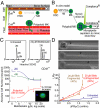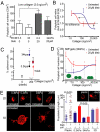Myosin-II inhibition and soft 2D matrix maximize multinucleation and cellular projections typical of platelet-producing megakaryocytes
- PMID: 21709232
- PMCID: PMC3136287
- DOI: 10.1073/pnas.1017474108
Myosin-II inhibition and soft 2D matrix maximize multinucleation and cellular projections typical of platelet-producing megakaryocytes
Abstract
Cell division, membrane rigidity, and strong adhesion to a rigid matrix are all promoted by myosin-II, and so multinucleated cells with distended membranes--typical of megakaryocytes (MKs)--seem predictable for low myosin activity in cells on soft matrices. Paradoxically, myosin mutations lead to defects in MKs and platelets. Here, reversible inhibition of myosin-II is sustained over several cell cycles to produce 3- to 10-fold increases in polyploid MK and a number of other cell types. Even brief inhibition generates highly distensible, proplatelet-like projections that fragment readily under shear, as seen in platelet generation from MKs in vivo. The effects are maximized with collagenous matrices that are soft and 2D, like the perivascular niches in marrow rather than 3D or rigid, like bone. Although multinucleation of other primary hematopoietic lineages helps to generalize a failure-to-fission mechanism, lineage-specific signaling with increased polyploidy proves possible and novel with phospho-regulation of myosin-II heavy chain. Label-free mass spectrometry quantitation of the MK proteome uses a unique proportional peak fingerprint (ProPF) analysis to also show upregulation of the cytoskeletal and adhesion machinery critical to platelet function. Myosin-inhibited MKs generate more platelets in vitro and also in vivo from the marrows of xenografted mice, while agonist stimulation activates platelet spreading and integrin αIIbβ3. Myosin-II thus seems a central, matrix-regulated node for MK-poiesis and platelet generation.
Conflict of interest statement
The authors declare no conflict of interest.
Figures






Similar articles
-
The abnormal proplatelet formation in MYH9-related macrothrombocytopenia results from an increased actomyosin contractility and is rescued by myosin IIA inhibition.J Thromb Haemost. 2013 Dec;11(12):2163-75. doi: 10.1111/jth.12436. J Thromb Haemost. 2013. PMID: 24165359
-
Pivotal role of PDK1 in megakaryocyte cytoskeletal dynamics and polarization during platelet biogenesis.Blood. 2019 Nov 21;134(21):1847-1858. doi: 10.1182/blood.2019000185. Blood. 2019. PMID: 31578203
-
OP9 bone marrow stroma cells differentiate into megakaryocytes and platelets.PLoS One. 2013;8(3):e58123. doi: 10.1371/journal.pone.0058123. Epub 2013 Mar 1. PLoS One. 2013. PMID: 23469264 Free PMC article.
-
New insights into cytoskeletal remodeling during platelet production.J Thromb Haemost. 2019 Sep;17(9):1430-1439. doi: 10.1111/jth.14544. Epub 2019 Jul 16. J Thromb Haemost. 2019. PMID: 31220402 Free PMC article. Review.
-
Mimicking megakaryopoiesis in vitro using biomaterials: Recent advances and future opportunities.Acta Biomater. 2019 Sep 15;96:99-110. doi: 10.1016/j.actbio.2019.07.025. Epub 2019 Jul 15. Acta Biomater. 2019. PMID: 31319203 Review.
Cited by
-
Enhancing the efficacy of drug-loaded nanocarriers against brain tumors by targeted radiation therapy.Oncotarget. 2013 Jan;4(1):64-79. doi: 10.18632/oncotarget.777. Oncotarget. 2013. PMID: 23296073 Free PMC article.
-
Hydrogel Micropost Arrays with Single Post Tunability to Study Cell Volume and Mechanotransduction.Adv Biosyst. 2020 Nov;4(11):e2000012. doi: 10.1002/adbi.202000012. Epub 2020 Oct 14. Adv Biosyst. 2020. PMID: 33053274 Free PMC article.
-
Nonmuscle myosin II exerts tension but does not translocate actin in vertebrate cytokinesis.Proc Natl Acad Sci U S A. 2012 Mar 20;109(12):4509-14. doi: 10.1073/pnas.1116268109. Epub 2012 Mar 5. Proc Natl Acad Sci U S A. 2012. PMID: 22393000 Free PMC article.
-
Multi-channel silk sponge mimicking bone marrow vascular niche for platelet production.Biomaterials. 2018 Sep;178:122-133. doi: 10.1016/j.biomaterials.2018.06.018. Epub 2018 Jun 17. Biomaterials. 2018. PMID: 29920404 Free PMC article.
-
Megakaryocyte migration defects due to nonmuscle myosin IIA mutations underlie thrombocytopenia in MYH9-related disease.Blood. 2020 May 21;135(21):1887-1898. doi: 10.1182/blood.2019003064. Blood. 2020. PMID: 32315395 Free PMC article.
References
-
- Straight AF, et al. Dissecting temporal and spatial control of cytokinesis with a myosin II Inhibitor. Science. 2003;299:1743–1747. - PubMed
-
- Engler AJ, Sen S, Sweeney HL, Discher DE. Matrix elasticity directs stem cell lineage specification. Cell. 2006;126:677–689. - PubMed
-
- Conti MA, Even-Ram S, Liu C, Yamada KM, Adelstein RS. Defects in cell adhesion and the visceral endoderm following ablation of nonmuscle myosin heavy chain II-A in mice. J Biol Chem. 2004;279:41263–41266. - PubMed
-
- De Lozanne A, Spudich JA. Disruption of the Dictyostelium myosin heavy chain gene by homologous recombination. Science. 1987;236:1086–1091. - PubMed
Publication types
MeSH terms
Substances
Grants and funding
LinkOut - more resources
Full Text Sources
Other Literature Sources

